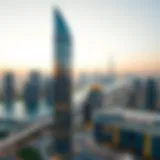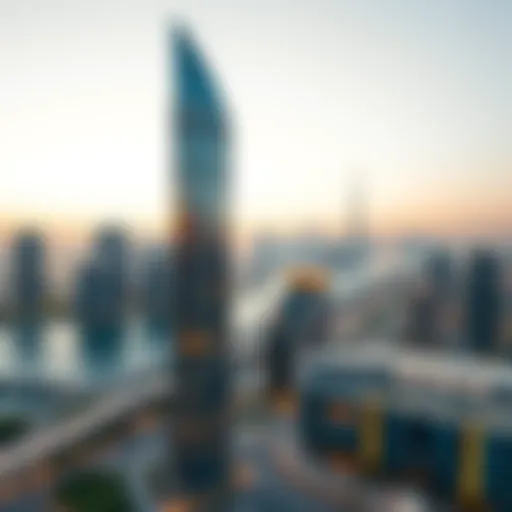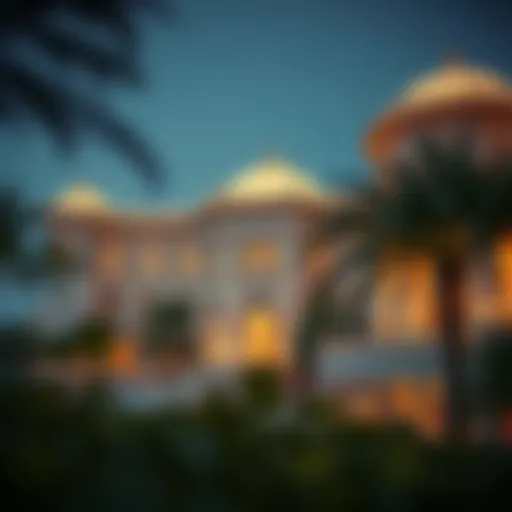Sustainable Living: Aldar's Vision for Future Cities


Intro
Sustainable living is no longer just a trend; it's becoming a necessity in modern urban development. With growing concerns about climate change and urban overcrowding, cities worldwide are exploring new ways to enhance the quality of life for residents while minimizing environmental impacts. Aldar Properties, a leading real estate developer in the UAE, stands at the forefront of this movement. Through its forward-thinking initiatives, Aldar is crafting a vision that blends innovation, technology, and community in creating a sustainable future.
This article digs deep into Aldar’s commitment toward designing sustainable cities, particularly within Dubai. Emphasizing the integration of ecological integrity, community connection, and cutting-edge technologies, we take a closer look at the strategies Aldar employs in its developments. Furthermore, this conversation touches on how these initiatives shape real estate dynamics, influence urban planning, and ultimately benefit societal well-being.
As we navigate through Aldar's pioneering efforts, our target audiences—real estate investors, expatriates, homebuyers, agents, and landlords—will find the insights crucial to understanding the evolving landscape of urban living and investment opportunities within Dubai's unique setting.
Let us embark on this exploration of sustainable living, examining not just what's being built but how it's transforming the fabric of everyday life in a city that is a blend of history and futuristic innovation.
Foreword to Sustainable Urban Development
Sustainable urban development has become a focal point in the discussion around city planning and construction, particularly in the context of addressing pressing global challenges such as climate change, resource depletion, and urbanization. As cities expand and populations increase, the need for environmentally responsible development becomes more critical. In this article, we will explore the importance of sustainable urban development in Aldar's vision for future cities, emphasizing the various elements that contribute to its success and the benefits it offers to a diverse range of stakeholders.
Understanding Sustainability in Urban Context
The concept of sustainability within an urban framework is multifaceted, encompassing not just environmental considerations but also social and economic dimensions. Urban sustainability refers to the practice of designing and managing cities intending to minimize the ecological footprint while providing a high quality of life for residents. This includes integrating green spaces, promoting public transportation, and ensuring that economic opportunities are accessible to all citizens.
In Aldar's approach, the focus on sustainability means creating resilient communities where nature and urban life coexist harmoniously. For example, incorporating vertical gardens and green rooftops in buildings not only enhances aesthetics but improves air quality. Moreover, sustainable cities prioritize the use of renewable energy sources, reducing dependency on fossil fuels. This creates a healthier environment and can lead to substantial savings for local governments and residents alike.
The Rise of Sustainable Cities Globally
Globally, there has been a marked shift towards sustainability, driven by both policy initiatives and grassroots movements. Cities such as Copenhagen and Singapore have emerged as leaders, showcasing how sustainable practices can be successfully integrated into urban design. What sets these cities apart is their commitment to making the environment a priority while fostering economic growth and social equity.
Various factors contribute to the rise of sustainable cities:
- Policy Support: Governments are increasingly enacting regulations and incentives favoring sustainable development. This can include tax breaks for green buildings or funding for public transport projects.
- Technological Advancements: Innovations in smart technology and renewable energy sources have made it easier to implement sustainable solutions, from energy-efficient homes to optimized waste management systems.
- Community Engagement: More than ever, citizens are becoming involved in advocating for sustainable practices, such as local sustainability councils and community gardening initiatives.
"Sustainability isn’t just a trend; it’s the future of urban living."
As we delve into the specifics of Aldar's initiatives, it becomes clear that their vision not only aligns with global trends but is also tailored to embrace the unique opportunities and challenges presented by Dubai's environment. This blend of global inspiration and local adaptability is key to fostering a sustainable urban landscape.
Aldar Properties and Sustainable City Concept
Sustainable urban development isn't just a trend—it's becoming a necessity in our increasingly urbanized world. Aldar Properties stands as a beacon in this movement, reshaping the landscape of real estate in the Middle East. Their concept of a sustainable city is not merely about constructing buildings; it's about forging a community where ecological balance and human well-being coalesce. This section delves into Aldar's manifold initiatives, bringing to light the elements that underline their commitment to sustainability.
Overview of Aldar Properties
Established in 2004, Aldar Properties has rapidly emerged as a prominent player in the real estate sector of Abu Dhabi. The company has built a reputation for championing quality, innovation, and sustainability in its developments. Aldar is involved in various aspects of urban design, from residential complexes like Al Raha Beach to mixed-use developments such as Yas Island. Their approach is distinct; they don’t just create spaces for living or working, they design environments that cater to the human experience.
In recent years, Aldar has shifted its focus toward creating communities that embody sustainable living principles. Such methods incorporate energy-efficient designs, smart home technologies, and ample green spaces. It's an investment not just in property, but in the future of urban living. Understanding Aldar’s ethos gives insight into the broader narrative of real estate trends, especially for potential investors and stakeholders.
Aldar’s Vision for Sustainability
Aldar’s vision for sustainability is comprehensive, intertwining ecological integrity, social equity, and economic viability. The company believes that the development of cities should respect and enhance the natural environment, rather than degrade it. A key element of this vision is the integration of sustainable practices across various stages of urban development.
For instance, Aldar has prioritized reducing carbon footprints through energy-efficient building designs that leverage renewable resources. Their projects often showcase innovative architectural techniques that allow for natural light maximization while minimizing the need for artificial heating and cooling. Clearly, it’s about more than just aesthetics; it’s a commitment to environmental responsibility.
Moreover, Aldar recognizes that sustainability extends beyond infrastructure. Community engagement plays a pivotal role. Their developments aim to create inclusive environments that encourage public participation and foster a sense of belonging among residents. This is evident through the establishment of parks, recreational areas, and cultural amenities that not only attract individuals but also strengthen community bonds.
Key Features of Aldar’s Sustainable City
Sustainable urban development hinges on the careful integration of various features that contribute to ecological balance, community well-being, and economic viability. Aldar’s sustainable city approach is not just a modern trend; it reflects a critical need for innovation in how urban spaces are planned and developed. These features help not only to improve the livability of the area but also to create environments that encourage a more sustainable lifestyle.
Innovative Architectural Design
The architecture within Aldar’s sustainable city goes beyond mere aesthetics, as it embodies functionality and sustainability. Utilizing biophilic design principles, buildings are crafted to harmonize with their natural surroundings. For instance, a building may incorporate vertical gardens, allowing for local flora to thrive while also improving air quality and providing insulation. Large windows and open spaces maximize natural light, which in turn can drastically reduce energy consumption.
Moreover, local materials are prioritized to minimize transportation emissions and support local economies. By doing this, Aldar not only reduces its carbon footprint but also instills a sense of cultural identity in the built environment.
Eco-friendly Landscaping and Green Spaces
Landscaping in Aldar’s city development is designed with the environment in mind. Green spaces are not an afterthought; they are strategically integrated into the urban fabric. Native plants are utilized in landscaping to ensure that the greenery requires minimal maintenance and irrigation, thus conserving water. Parks and community gardens foster biodiversity and act as critical habitats for local wildlife.
The design also incorporates rain gardens and permeable pavements, which help manage stormwater effectively, mitigating flood risks while also filtering pollutants. These spaces serve as communal hubs that not only enhance mental health but also promote community interaction, which is essential for social sustainability.
Energy Efficiency Initiatives
Energy efficiency is a cornerstone of Aldar’s sustainable vision. The city harnesses renewable energy sources, such as solar and wind, to power its infrastructure. Every building is equipped with smart meters that enable residents to monitor their energy consumption in real time, encouraging a mindful approach to energy use. By employing energy-efficient appliances and systems, waste is reduced significantly, benefiting both residents and the environment.


Retrofitting existing structures with advanced energy-efficient technologies also plays a vital role in reducing overall energy demand. This not only contributes to a greener city but also results in lower utility costs for residents.
"Aldar is paving the way for future urban living, setting a benchmark for sustainable practices in modern architecture and community development."
Impact of Green Building Practices
The building practices that adhere to green principles are becoming increasingly relevant in modern urban development, particularly as cities strive to become more sustainable. In the context of Aldar's vision for future cities, the impact of green building practices deserves thorough exploration. These practices encompass various strategies geared towards minimizing environmental harm while maximizing social and economic value. Incorporating eco-friendly construction materials, reducing energy consumption, and enhancing the overall quality of life for residents are just a few ways that sustainable architecture can bring about notable change.
Benefits of Sustainable Construction
Sustainable construction is not just a passing trend; it has wide-ranging benefits that guarantee its place in the future of urban landscapes. Firstly, buildings designed with sustainability in mind usually lead to lower operational costs over time. This reduction comes from energy-efficient technologies and materials that lessen the need for utilities. For instance, many green buildings are equipped with solar panels which, while requiring an up-front investment, enable substantial cost savings on electricity in the long haul.
In addition to financial gains, sustainable buildings often create healthier environments for occupants. Poor indoor air quality can lead to a host of health issues, but green building practices incorporate the use of non-toxic materials and greater ventilation. This enhancement drives home the point that sustainable construction can have tangible benefits for public health by reducing allergens and other harmful pollutants.
Furthermore, these buildings often increase the value of their surroundings. Properties constructed with a focus on sustainability attract more discerning buyers. When an investor sees a commitment to green building practices, it provides confidence in the property’s durability and livability. This can lead to higher demand and, consequently, increases property values in those areas, reflecting a notable trend among eco-conscious real estate investors.
Long-term Economic Advantages
Long-term economic advantages of sustainable building extend well beyond immediate cost savings. They imply a shift toward a more resilient economy. Buildings that are energy-efficient and environmentally friendly can facilitate job creation in green technologies and construction practices. This economic shift can stimulate growth in various sectors, ultimately leading to a robust job market for skilled workers in sustainable industries.
Investing in sustainable buildings can enhance the overall competitiveness of a city. Cities that prioritize green development may appeal to high-tech industries and progressive companies seeking environmentally conscious venues. As these companies frequent greener urban centers, they bring their workers along, which stimulates local economies through housing demands, retail, and service employment.
Moreover, the long-term operational efficiencies foster enhanced resilience against fluctuating energy prices and climate-related risks. By investing in renewable energy sources and sustainable technology now, cities can position themselves favorably for future challenges, such as rising energy costs or stricter environmental regulations.
"Sustainable practices are not merely an option; they are a pathway to a prosperous future amidst changing global landscapes."
In sum, Aldar's emphasis on green building practices reveals a commitment not only to current sustainability but the resilience of future urban development. By understanding both the benefits of sustainable construction and the long-term economic advantages, stakeholders including real estate investors and community leaders can recognize the profound impact these innovations have on shaping the cities of tomorrow.
Transportation and Mobility in Sustainable Cities
Transportation plays a pivotal role in shaping the urban experience. Within the context of Aldar’s vision for sustainable living, an efficient and environmentally friendly transportation system stands out as both a goal and a necessity. It’s not just about getting from point A to point B. It’s about weaving together the fabric of a sustainable city, enhancing accessibility, and prioritizing the well-being of residents.
Cities that prioritize transportation and mobility create a ripple effect across various sectors. Good transport systems reduce congestion, improve air quality, and can even promote economic growth. With Aldar’s focus on sustainable cities, exploring integrated transport solutions becomes paramount. The transition towards more sustainable means of commuting not only enriches the quality of life but also aligns with broader environmental goals.
Integrated Public Transport Solutions
Aldar's commitment to sustainability encompasses innovative public transport systems that serve as the backbone of future urban mobility. Integrated public transport doesn’t merely refer to buses and metro systems. It’s about creating a comprehensive network that seamlessly connects different modes of transport.
Imagine stepping off a metro train and having immediate access to electric buses, bike-sharing stations, and even carpooling options. This interconnectedness facilitates commuting and minimizes reliance on personal vehicles, reducing emissions dramatically. Not only does this approach ease traffic burdens, but it also lowers operational costs in maintaining urban infrastructure. Here are a few key elements of integrated public transport solutions:
- Multi-modal Connectivity: Seamless transitions between different transport modes, ensuring convenient access for all users.
- Real-time Data Sharing: Mobile applications providing up-to-date information on schedules, delays, and changes, improving commuter efficiency.
- Sustainability in Design: Eco-friendly vehicles and energy-efficient stations that minimize environmental impact.
The importance of an integrated public transport system cannot be understated, especially in fostering a compact urban environment. It also acts as a luring incentive for expatriates and homebuyers looking for modern, interconnected living.
Promoting Walkability and Cycling
Encouraging walkability and cycling in urban design is another cornerstone of Aldar’s sustainable vision. Walkable cities are developed with pedestrians in mind, offering safe and enjoyable routes for walking and biking. Such places highlight not just mobility but a lifestyle that enhances community engagement.
The benefits of promoting walkability and cycling extend beyond just transportation. They foster healthier lifestyles, reduce traffic congestion, and contribute to lower greenhouse gas emissions. Here's how it's structured within Aldar’s initiatives:
- Well-designed Pathways: Wide sidewalks, dedicated bike lanes, and pedestrian-friendly crossings ensure safety and comfort.
- Public Spaces: Creating parks and recreational areas encourages people to walk more, supporting a bustling community atmosphere.
- Cycling Facilities: Provision of bike racks, repair stations, and rental services makes cycling a viable and attractive option for all residents.
By placing emphasis on these modes of mobility, Aldar is not only cultivating a healthier population but also enriching the overall urban experience. Residents can enjoy a more active lifestyle, free from the drawbacks of congested roads.
"In sustainable cities, urban transportation isn’t an isolated component; it’s part of a holistic vision that shapes communities and connects people."
Ultimately, transportation and mobility in Aldar’s sustainable city framework symbolize more than just transit; they represent a shift towards cultivating vibrant, interactive communities that appreciate the value of both people and the environment. Ensuring the vision's practical implementation will be a monumental step towards achieving a truly sustainable urban lifestyle.
Community Engagement and Social Sustainability
Community engagement plays a pivotal role in achieving sustainability within urban environments, especially in the context of Aldar's vision for future cities. It emphasizes the necessity of collective action and cooperation among residents to shape their living spaces into vibrant and sustainable communities. The heart of social sustainability lies in a community that feels connected, valued, and actively participates in local decision-making processes. When residents engage, they don't just reside in a place; they become integral to the community's evolution and resilience.
Fostering a Sense of Community
Aldar recognizes that fostering a sense of community goes beyond merely creating residential spaces. This approach is multifaceted, involving initiatives that bring people together. Perhaps one of the best examples is community gardens, where residents can cultivate plants while getting to know their neighbors. Such spaces encourage interaction and promote a shared sense of responsibility toward both the environment and fellow residents.
Moreover, social events, workshops, and cultural festivals create bonds among individuals. Imagine a local art fair where artists showcase their work, providing not only a platform for self-expression but also a means for residents to support local talent. These gatherings enrich the social fabric, turning a neighborhood into a genuine community rather than just a collection of houses.
Cultural and Recreational Facilities
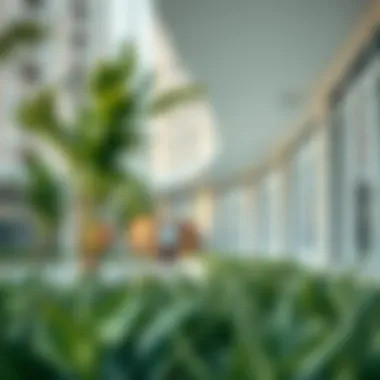

In tandem with fostering community ties, the provision of cultural and recreational facilities is crucial in promoting social sustainability. These facilities serve as hubs where people can engage in leisure activities, participate in cultural exchanges, and pursue personal development. Parks, sports complexes, and community centers are more than just amenities; they're vital for enhancing the quality of life.
When planning Aldar's sustainable cities, incorporating multipurpose spaces is essential. Having an area for sports not only encourages physical activity but can also host community events or festivals, making it a vital part of the urban landscape.
In addition, cultural facilities like theaters, galleries, or museums can provide residents with opportunities to explore arts and heritage. Access to cultural offerings builds pride among community members and connects them to their roots, which can be especially meaningful in a cosmopolitan setting like Dubai.
In summary, community engagement and the availability of rich cultural and recreational opportunities greatly contribute to social sustainability within Aldar’s urban developments. They help in nurturing a robust, interconnected populace that is committed to environmental and social stewardship, ultimately cementing the foundation for future cities built on collaboration, respect, and inclusivity.
"Creating sustainable cities is not just about buildings; it's about building relationships within those spaces."
For more insights on community building, see these resources from Wikipedia and Britannica.
Technological Innovations in Sustainable Cities
Technological advancements play a crucial role in the evolution of sustainable cities. Housing plans and urban design don’t just need imagination; they depend heavily on the smart application of technology. In the context of Aldar’s vision, integrating cutting-edge innovations is vital for creating livable, functional, and eco-friendly urban environments.
Smart Home Technologies
The concept of smart homes has gained traction, especially in developing sustainable cities. These homes utilize internet-connected devices to enhance efficiency and comfort. Think about it: having a thermostat that learns your habits can significantly cut energy consumption. Smart home technologies not only provide convenience but also contribute to sustainability by monitoring and managing energy use intelligently.
For instance, integrated systems allow homeowners to control lighting, heating, and appliances remotely, optimizing power consumption. Sensors can detect when a room is empty, automatically turning off lights and adjusting heating or cooling. This results in utility savings and decreased carbon footprints on both the residential and community levels.
Here are some notable benefits:
- Energy Efficiency: Lower energy bills through optimized usage.
- Enhanced Comfort: Customizable environments that cater to individual preferences.
- Increased Property Value: Homes equipped with smart technology can attract more buyers, making them more valuable on the market.
Integration of Renewable Energy Sources
As cities evolve, integrating renewable energy sources becomes non-negotiable. The relentless push towards sustainability places solar, wind, and geothermal energy at the forefront of urban development initiatives. Aldar's sustainable vision includes utilizing these renewable sources to empower communities, ensuring they aren't just passive consumers of energy but active participants in generating it.
For example, solar panels on rooftops in Aldar’s developments not only diminish reliance on grid energy but also harness the sun’s power to lower overall energy costs. Consider this:
"By 2050, the aim is for the UAE to have 50% of its energy produced from renewable sources." This monumental shift underscores the growing commitment to sustainable energy practices.
The following aspects are crucial when integrating renewables into urban settings:
- Infrastructure Development: New buildings should support installation of solar panels or wind turbines.
- Community Energy Projects: Localized solar farms can empower neighborhoods to share in energy production and savings.
- Regulatory Support: Government incentives could encourage homeowners and businesses to invest in renewable technologies, making sustainable energy both accessible and economical.
Conclusively, technological innovations—in the form of smart home technologies and renewable energy integration—are integral to Aldar's approach in shaping future cities. They are not mere add-ons but foundational elements that elevate urban living to new sustainable heights.
Regulatory Framework and Policies Supporting Sustainability
When it comes to the development of sustainable urban environments, the role of regulatory frameworks and policies cannot be overstated. These guidelines help boost responsible growth, ensuring that the balance between ecological sustainability and urban expansion is delicately maintained. A strong policy framework sets the stage for various initiatives aimed at promoting sustainability, providing clear standards and expectations for both public and private entities engaged in urban development.
Moreover, these regulations often carry the double-edged sword of incentivizing sustainable practices while imposing necessary restrictions to mitigate environmental degradation. It's like having a roadmap; without it, navigating the complex terrain of urban sustainability can quickly become a tangled mess.
Local Government Initiatives
Local authorities play an essential role in fostering sustainability within their jurisdictions. Initiatives might include the implementation of green building codes, which require or encourage the adoption of eco-friendly materials and energy-efficient designs. These regulations help lower carbon footprints, making urban environments more livable and resilient to climate shifts.
Moreover, many local governments introduce renewable energy incentives to encourage homeowners and businesses to utilize solar panels or wind energy. Tailoring policies to support local demographics and ecosystems is vital. Not only does this drive economic growth through emerging sectors like the clean tech industry, but it also cultivates community pride and involvement.
“Sustainability isn’t just about what we do; it’s also about how we do it, creating a culture of sustainability that permeates daily life.”
Here are some examples of local government initiatives that showcase this commitment:
- Green Zoning Laws: Designating specific areas for sustainable developments, which often limits the type of construction allowed to only those meeting stricter environmental standards.
- Public Transportation Projects: Expanding infrastructure to support electric buses and bike-sharing programs reduces the dependency on automobiles.
- Community Education Programs: Offering workshops and resources to inform residents about the importance of sustainable practices, from recycling to water conservation.
International Standards in Sustainable Development
While local initiatives are crucial, they often align with international standards that set the benchmark for sustainability practices worldwide. Organizations such as the United Nations have established goals, like the Sustainable Development Goals (SDGs), which encourage nations to promote environmental stewardship while meeting societal needs.
Countries, especially those with ambitions of becoming leaders in sustainable development, often look to these guidelines when crafting their regulatory frameworks. These frameworks help ensure that cities are not just confined to an isolated context but rather contribute to a broad vision shared globally.
Incorporating international standards into local regulations provides a diverse range of benefits, including:
- Global Collaboration: Facilitates partnerships with other nations and organizations, allowing for the exchange of ideas and technologies.
- Funding Opportunities: Compliance with international norms can improve eligibility for grants, donations, or investments from global funds focused on sustainable development.
- Consistency: Establishes a common language and set of criteria that can streamline processes when working across borders.
For more information on international sustainability standards, you can refer to UN Sustainable Development Goals and other relevant resources.
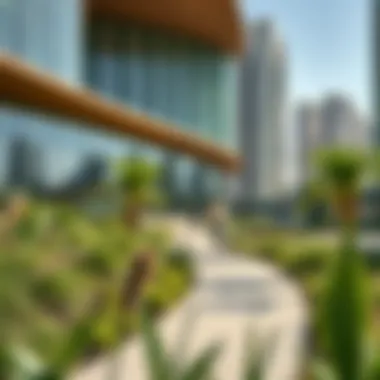

Challenges in Implementing Sustainable Practices
Sustainable practices are vital for the future evironment of our cities, yet they face a plethora of challenges that can hinder effective implementation. Understanding these difficulties not only helps recognize the roadmap for success but also allows stakeholders to plan strategically. In Aldar’s initiatives, navigating these challenges is pivotal for creating a sustainable city that fosters both ecological integrity and community wellbeing.
Financial Constraints and Investment Risks
One of the primary hurdles in bringing sustainable practices to life revolves around financial constraints. Quite simply, sustainable construction projects and eco-friendly initiatives often require hefty investments upfront. Many investors may view these expenditures as risky, especially if the economic return isn't immediately clear or assured.
- Capital Investment: Green technologies, energy-efficient designs, and infrastructure improvements often demand more initial capital than traditional methods. This can lead to financial hesitation.
- Economic Uncertainty: Fluctuations in the market can make long-term projects riskier. Investors may shy away from backing initiatives that don’t promise quick financial payoffs.
Consequently, collaboration between the private and public sectors may emerge as a solution. For instance, joint ventures can distribute financial risk, making sustainable projects more attractive to investors. The integration of government incentives can also potentiate public interest and lead to greater collective financial backing.
Public Perception and Education
Next up, the role of public perception and education cannot be downplayed. Many potential residents and stakeholders may not fully grasp the benefits of sustainable living, viewing eco-friendly structures as merely an aesthetic choice or opting for traditional options out of familiarity.
- Awareness Campaigns: It’s essential to communicate how sustainability directly impacts their daily lives—ranging from lower utility bills to improved air quality.
- Community Workshops: Educational initiatives can bridge the information gap, allowing individuals to engage with sustainable concepts firsthand.
"The success of sustainable city initiatives is contingent upon public support, grounded in understanding."
Efforts must be undertaken to make sustainability relatable. For example, involving community members in the planning stages can foster a sense of ownership and commitment toward sustainable practices. Such collaborative approaches can build momentum, making the challenges in adopting sustainable methods less formidable.
Ultimately, identifying challenges such as financial constraints and public perception leads to a more nuanced understanding of the sustainable journey Aldar envisions. Enhanced dialogue and cross-sector collaboration might just be the keys to unlocking a future where sustainable living is not just a goal but a reality.
Future Prospects and Developments
As we look into the crystal ball of urban evolution, the significance of future prospects and developments becomes crystal clear. Aldar’s commitment towards sustainable living is not just a mere trend but is becoming a foundational element for what cities will become. This section discusses key aspects that will shape not only urban landscapes but also societal behaviors in the years to come.
Vision for Future Urban Developments
Aldar envisions a future where urban areas are ecologically balanced, technologically advanced, and socially inclusive. The focus is on creating environments that resonate with the needs of their residents while prioritizing sustainability.
To break it down, here are some crucial features of this vision:
- Smart Urban Planning: This involves zoning strategies that prioritize green spaces, reducing congestion, and improving accessibility for all.
- Decentralization of Resources: By promoting local energy generation and food production, communities can rely less on distant resources, fostering resilience and sustainability.
- Enhancement of Infrastructure: Development of efficient waste management systems and water conservation technologies aims to alleviate the pressure on local ecosystems.
In addition, Aldar emphasizes public transportation, ensuring that residents have multiple eco-friendly ways to commute. The convenience of such systems can reduce car dependency, which directly contributes to lower carbon emissions.
Scaling Sustainable Practices Beyond Aldar
Implementing sustainable practices within Aldar’s projects is only the tip of the iceberg; the challenge lies in scaling these initiatives to a broader context. For other developers, towns, or even countries to emulate Aldar’s success, certain considerations are essential:
- Partnerships: Collaborating with local governments to align sustainability goals can multiply the impact of Aldar’s practices. This can mean sharing insights on sustainable construction techniques or co-developing green public transportation systems.
- Training and Education: Equipping local builders, contractors, and even residents with knowledge on sustainable practices is crucial. Workshops or certification programs can nurture a workforce that genuinely understands these principles and their benefits.
- Influence of Policies: Advocating for policies that support green practices can create a necessity for sustainable development across various sectors. Engaging with stakeholders in the policymaking process can facilitate the push for broader adoption of these innovative solutions.
"Sustainability is a journey, not a destination. The road is paved with choices that require involvement and commitment from all sectors of society."
The key takeaway here is that embracing these future prospects isn't just a responsibility of one entity; it's a collective journey that involves investors, developers, and the community. With Aldar setting an example, the hope is that their projects inspire wider adoption of sustainable living practices, leading to greener cities around the globe.
For more information about sustainable practices, check resources like Wikipedia on Sustainable Development and articles from organizations such as The World Bank.
Understanding these developments is essential, particularly for real estate investors, expatriates, homebuyers, agents, and landlords who are poised to benefit from this transformational shift.
The End
In reflecting on the strides Aldar is taking towards developing sustainable urban environments, it becomes evident that fostering a holistic approach is more than a trend—it's a necessity. As urban centers face the trials of climate change, population growth, and resource depletion, the relevance of this discussion cannot be overstated.
Summarizing Key Insights
Aldar’s commitment encompasses multiple dimensions of sustainable urban living. This includes the integration of green building practices, innovative transit solutions, and a framework that encourages community participation. Each effort enhances the livability of the environment, ensuring that both current and future generations can enjoy a comfortable, clean, and thriving urban lifestyle.
- Key points:
- Focus on Ecosystem Preservation: Fast-tracking initiatives that improve biodiversity and reduce waste.
- Investing in Technology: Implementation of smart grids and renewable energy sources, making daily living more efficient.
- Community Involvement: Creating spaces where people can engage with one another, fostering not just a community but a responsive stakeholder environment.
In short, Aldar's vision serves as a blueprint not just for urban developers but also for policymakers and urban residents alike. The initiatives outlined within the article shine a light on how sustainability can be effectively woven into the fabric of daily urban life, driving economic prosperity while safeguarding environmental integrity.
Call to Action for Sustainable Living
The time is ripe for individuals, investors, and community leaders to come together and actively engage in the dialogue of sustainable development. Citizens should not only consider housing with eco-friendly features but also advocate for policies that prioritize sustainable practices on a broader scale.
- Engagement Ideas:
- Participate in Community Workshops: Learn about and influence development plans in your area.
- Support Local Green Initiatives: Investing in local businesses that prioritize sustainability can create a ripple effect of positive change.
- Educate and Advocate: Share information on the benefits of sustainable practices within your network to increase community awareness.
Engaging in sustainable living doesn't merely reflect a trend; it indicates a profound shift in how we perceive and interact with our environment. Every small action counts; when multiplied across a community, these efforts can lead to impactful and lasting change. Together, adopting these methods can potentially turn aspirations into actionable realities, making cities not just livable but lovable.
“Sustainable living is not just a philosophy; it is a conscious choice that shapes our present and defines our future.”
Understanding Aldar’s pioneering vision ultimately sets the stage for what urban living could (and should) look like in a future that values sustainability as a core principle. By galvanizing support for these initiatives, we can all play a significant role in building a better tomorrow.


